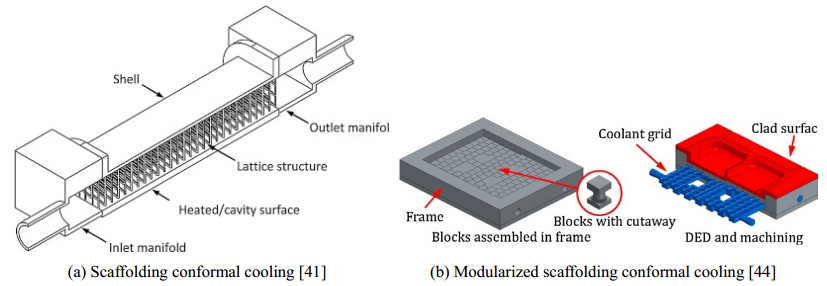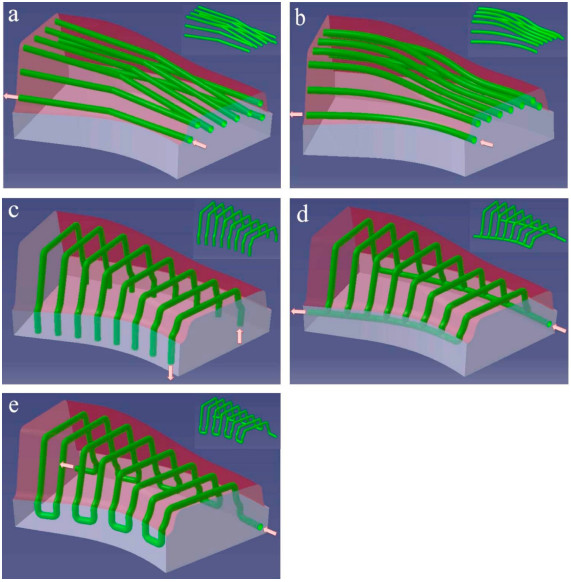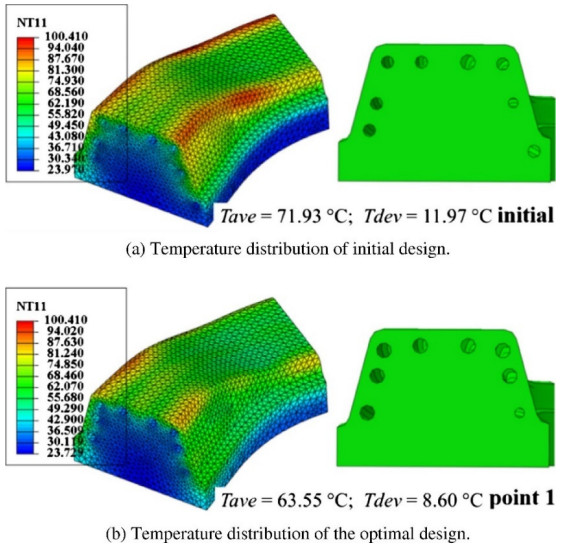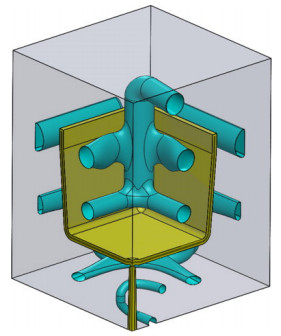|
[1]
|
P. Wang, B. Zou, S. Ding, C. Huang, Z. Shi, Y. Ma, et al., Preparation of short CF/GF reinforced PEEK composite filaments and their comprehensive properties evaluation for FDM-3D printing, Compos. Part B Eng., 198 (2020), 108175.
|
|
[2]
|
P. Wang, B. Zou, H. C. Xiao, S. Ding, C. Huang, Effects of printing parameters of fused deposition modeling on mechanical properties, surface quality, and microstructure of PEEK, J. Mater. Process. Technol., 271 (2019), 62-74.
|
|
[3]
|
J. K. Liu, Y. S. Ma, J. Y. Fu, K. Duke, A novel CACD/CAD/CAE integrated design framework for fiber-reinforced plastic parts, Adv. Eng. Software, 87 (2015), 13-29.
|
|
[4]
|
E. Vojnova, The benefits of a conforming cooling systems the molds in injection moulding process, Procedia Eng., 149 (2016), 535-543.
|
|
[5]
|
Y. Wang, K. M. Yu, C. C. L. Wang, Y. Zhang, Automatic design of conformal cooling circuits for rapid tooling, Comput. Aided Des., 43 (2011), 1001-1010.
|
|
[6]
|
L. Li, Y. F. Zheng, M. L. Yang, J. Leng, Z. Cheng, Y. Xie, et al., A survey of feature modeling methods: Historical evolution and new development, Rob. Comput. Integr. Manuf., 61 (2020), 101851.
|
|
[7]
|
M. Bendsøe, O. Sigmund, Topology Optimization: Theory, Method and Applications, Berllin, Heidelberg, Springer, 2003.
|
|
[8]
|
J. K. Liu, A. T. Gaynor, S. K. Chen, Z. Kang, K. Suresh, A. Takezawa, et al., Current and future trends in topology optimization for additive manufacturing, Struct. Multidiscip. Optim., 57 (2018), 2457-2483.
|
|
[9]
|
Z. Li, X. Y. Wang, J. F. Gu, S. Ruan, C. Shen, Y. Lyu, et al., Topology Optimization for the Design of Conformal Cooling System in Thin-wall Injection Molding Based on BEM, Int. J. Adv. Manuf. Technol., 94 (2018), 1041-1059.
|
|
[10]
|
T. Wu, A. Tovar, Design for Additive Manufacturing of Conformal Cooling Channels Using Thermal-Fluid Topology Optimization and Application in Injection Molds, Proceedings of the Asme International Design Engineering Technical Conferences and Computers and Information in Engineering Conference, 2018.
|
|
[11]
|
L. Meng, W. H. Zhang, D. L. Quan, G. Shi, L. Tang, Y. Hou, From Topology Optimization Design to Additive Manufacturing: Today's Success and Tomorrow's Roadmap, Arch. Comput. Methods Eng., 27 (2020), 805-830.
|
|
[12]
|
J. Q. Huang, Q. Chen, H. Jiang, B. Zou, L. Li, J. Liu, et al., A survey of design methods for material extrusion polymer 3D printing, Virtual Phys. Prototyping, 15 (2020), 148-162.
|
|
[13]
|
J. K. Liu, Y. S. Ma, A survey of manufacturing oriented topology optimization methods, Adv. Eng. Software, 100 (2016), 161-175.
|
|
[14]
|
D. Brackett, I. Ashcroft, R. Hague, Topology optimization for additive manufacturing, 22nd Annual International Solid Freeform Fabrication Symposium-An Additive Manufacturing Conference, 2011.
|
|
[15]
|
J. Y. Fu, Y. S. Ma, A method to predict early-ejected plastic part air-cooling behavior towards quality mold design and less molding cycle time, Rob. Comput. Integr. Manuf., 56 (2019), 66-74.
|
|
[16]
|
J. Y. Fu, Y. S. Ma, Computer-aided engineering analysis for early-ejected plastic part dimension prediction and quality assurance, Int. J. Adv. Manuf. Technol., 98 (2018), 2389-2399.
|
|
[17]
|
H. M. Zhou, D. Q. Li, Mold cooling simulation of the pressing process in TV panel production, Simul. Modell. Pract. Theory, 13 (2005), 273-285.
|
|
[18]
|
S. J. Park, T. H. Kwon, Optimal cooling system design for the injection molding process, Polym. Eng. Sci., 38 (1998), 1450-1462.
|
|
[19]
|
E. Sachs, E. Wylonis, S. Allen, M. Cima, H. Guo, Production of injection molding tooling with conformal cooling channels using the three dimensional printing process, Polym. Eng. Sci., 40 (2000), 1232-1247.
|
|
[20]
|
A. S. Sachs, S. Allen, H. Guo, J. Banos, M. Cima, J. Serdy, et al., Progress on tooling by 3D printing; conformal cooling, dimensional control, surface finish and hardness, Proceedings of the Eighth Annual Solid Freeform Fabrication Symposium, 1997.
|
|
[21]
|
G. Venkatesh, Y. R. Kumar, G. Raghavendra, Comparison of Straight Line to Conformal Cooling Channel in Injection Molding, Mater. Today Proc., 4 (2017), 1167-1173.
|
|
[22]
|
C. T. Lu, G. S. Chen, S. C. Tseng, Effectiveness of Conformal Cooling for a V-Shaped Plate and its Influence on Warpage: 2017 International Conference on Information, Communication and Engineering (ICICE), 2017.
|
|
[23]
|
M. Mazur, P. Brincat, M. Leary, M. Brandt, Numerical and experimental evaluation of a conformally cooled H13 steel injection mould manufactured with selective laser melting, Int. J. Adv. Manuf. Technol., 93 (2017), 881-900.
|
|
[24]
|
M. Khan, S. Afaq, N. Khan, S. Ahmad, Cycle Time Reduction in Injection Molding Process by Selection of Robust Cooling Channel Design, ISRN Mech. Eng., 2014 (2014), 968484.
|
|
[25]
|
A. B. M. Saifullah, S. H. Masood, I. Sbarski, New Cooling Channel Design for Injection Moulding, World Congress on Engineering, 2009.
|
|
[26]
|
Z. Shayfull, S. Sharif, A. M. Zain, R. M. Saad, M. A. Fairuz, Milled Groove Square Shape Conformal Cooling Channels in Injection Molding Process, Mater. Manuf. Processes, 28 (2013), 884-891.
|
|
[27]
|
S. Z. A. Rahim, S. Sharif, A. M. Zain, S. M. Nasir, R. M. Saad, Improving the Quality and Productivity of Molded Parts with a New Design of Conformal Cooling Channels for the Injection Molding Process, Adv. Polym. Technol., 35 (2016).
|
|
[28]
|
M. Kamarudin, M. S. Wahab, M. Batcha, Z. Shayfull, A. A. Raus, A. Ahmed, Cycle time improvement for plastic injection moulding process by sub groove modification in conformal cooling channel, AIP Conference Proceedings, 1885 (2017), 020176.
|
|
[29]
|
A. J. Norwood, P. M. Dickens, R. C. Soar, R. Harris, G. Gibbons, R. Hansell, Analysis of cooling channels performance, Int. J. Comput. Integr. Manuf., 17 (2004), 669-678.
|
|
[30]
|
Y. Wang, K. M. Yu, C. C. L. Wang, Spiral and conformal cooling in plastic injection molding, Comput. Aided Des., 63 (2015), 1-11.
|
|
[31]
|
H. S. Park, N. H. Pham, Design of Conformal Cooling Channels for an Automotive Part, Int. J. Automot. Technol., 10 (2009), 87-93.
|
|
[32]
|
F. H. Hsu, K. Wang, C. T. Huang, R. Y. Chang, Investigation on conformal cooling system design in injection molding, Adv. Prod. Eng. Manage., 8 (2013), 107-115.
|
|
[33]
|
K. M. Au, K. M. Yu, W. K. Chiu, Visibility-based conformal cooling channel generation for rapid tooling, Comput. Aided Des., 43 (2011), 356-373.
|
|
[34]
|
K. M. Au, K. M. Yu, Variable Distance Adjustment for Conformal Cooling Channel Design in Rapid Tool, J. Manuf. Sci. Eng. Trans. Asme, 136 (2014), 044501.
|
|
[35]
|
A. B. M. Saifullah, S. H. Masood, I. Sbarski, Thermal-structural analysis of bi-metallic conformal cooling for injection moulds, Int. J. Adv. Manuf Technol., 62 (2012), 123-133.
|
|
[36]
|
B. Zink, F. Szabo, I. Hatos, A. Suplicz, N. K. Kovács, H. Hargitai, et al., Enhanced Injection Molding Simulation of Advanced Injection Molds, Polymers, 9 (2017), 77.
|
|
[37]
|
K. Eiamsa-Ard, K. Wannissorn, Conformal bubbler cooling for molds by metal deposition process, Comput. Aided Des., 69 (2015), 126-133.
|
|
[38]
|
K. M. Au, K. M. Yu, A scaffolding architecture for conformal cooling design in rapid plastic injection moulding, Int. J. Adv. Manuf. Technol., 34 (2007), 496-515.
|
|
[39]
|
K. M. Au, K. M. Yu, Modeling of multi-connected porous passageway for mould cooling, Comput. Aided Des., 43 (2011), 989-1000.
|
|
[40]
|
Y. Tang, Z. Gao, Y. Zhao, Design of Conformal Porous Structures for the Cooling System of an Injection Mold Fabricated by Additive Manufacturing Process, J. Mech. Des., 141 (2019), 101702.
|
|
[41]
|
H. Brooks, K. Brigden, Design of conformal cooling layers with self-supporting lattices for additively manufactured tooling, Addit. Manuf., 11 (2016), 16-22.
|
|
[42]
|
F. Marin, J. R. de Miranda, A. F. de Souza, Study of the design of cooling channels for polymers injection molds, Polym. Eng. Sci., 58 (2018), 552-559.
|
|
[43]
|
L. Cheng, J. K. Liu, X. Liang, A. C. To, Coupling lattice structure topology optimization with designdependent feature evolution for additive manufactured heat conduction design, Comput. Methods Appl. Mech. Eng., 332 (2018), 408-439.
|
|
[44]
|
M. Soshi, J. Ring, C. Young, Y. Oda, M. Mori, Innovative grid molding and cooling using an additive and subtractive hybrid CNC machine tool, Cirp Ann., 66 (2017), 401-404.
|
|
[45]
|
X. H. Ding, K. Yamazaki, Constructal design of cooling channel in heat transfer system by utilizing optimality of branch systems in nature, J. Heat Transfer Trans. Asme, 129 (2007), 245-255.
|
|
[46]
|
J. H. Choi, J. S. Kim, E. S. Han, H. P. Park, B. O. Rhee, Study on an Optimized Configuration of Conformal Cooling Channel by Branching Law, Proceedings of the Asme 12th Biennial Conference on Engineering Systems Design and Analysis, 2014.
|
|
[47]
|
P. Hu, B. He, L. Ying, Numerical investigation on cooling performance of hot stamping tool with various channel designs, Appl. Therm. Eng., 96 (2016), 338-351.
|
|
[48]
|
S. A. Jahan, H. El-Mounayri, Optimal Conformal Cooling Channels in 3D Printed Dies for Plastic Injection Molding, Procedia Manuf., 5 (2016), 888-900.
|
|
[49]
|
S. A. Jahan, T. Wu, Y. Zhang, et al., Thermo-mechanical design optimization of conformal cooling channels using design of experiments approach, Procedia Manuf., 10 (2017), 898-911.
|
|
[50]
|
L. Li, Z. R. Cheng, C. F. Lange, CFD-Based Optimization of Fluid Flow Product Aided by Artificial Intelligence and Design Space Validation, Math. Probl. Eng., 2018 (2018), 8465020.
|
|
[51]
|
B. He, L. Ying, X. D. Li, P. Hu, Optimal design of longitudinal conformal cooling channels in hot stamping tools, Appl. Therm. Eng., 106 (2016), 1176-1189.
|
|
[52]
|
G. Venkatesh, Y. Kumar, Thermal Analysis for Conformal Cooling Channel, Mater. Today Proc., 4 (2017), 2592-2598.
|
|
[53]
|
M. H. M. Hazwan, Z. Shayfull1, S. Sharif, S. M. Nasir, M. M. Rashidi, Warpage optimisation on the moulded part with straight-drilled and MGSS conformal cooling channels using response surface methodology (RSM), AIP Conference Proceedings, 2017.
|
|
[54]
|
M. Hazwan, S. Z. Abd. Rahim, S. Sharif, M. Saad, Warpage Optimisation on the Moulded Part with Conformal Cooling Channels using Response Surface Methodology (RSM) and Glowworm Swarm Optimisation (GSO), AIP Conference Proceedings, 2017.
|
|
[55]
|
S. Z. A. R. M. Hazwan, S. Sharif, M.N. Mat Saad, M. Rashidi, Warpage optimisation on the moulded part with conformal cooling channels using response surface methodology (RSM) and genetic algorithm (GA) optimisation approaches, AIP Conference Proceedings, 2017.
|
|
[56]
|
M. Hazwan, Z. Shayfull1, S. Sharif, S. M. Nasir, M. M. Rashidi, Warpage Optimisation on the Moulded Part using Response Surface Methodology (RSM) and Glowworm Swarm Optimisation (GSO), MATEC Web of Conferences, 2017.
|
|
[57]
|
M. H. M. Hazwan, Z. Shayfull1, S. Sharif, N. Zainal, S. M. Nasir, Optimisation of warpage on plastic injection moulding part with MGSS conformal cooling channels moulds using response surface methodology (RSM): AIP Conference Proceedings. 2017.
|
|
[58]
|
X. P. Dang, H. S. Park, Design of U-shape Milled Groove Conformal Cooling Channels for Plastic Injection Mold, Int. J. Precis. Eng. Manuf., 12 (2011), 73-84.
|
|
[59]
|
S. Kitayama, H. Miyakawa, M. Takano, S. Aiba, Multi-objective optimization of injection molding process parameters for short cycle time and warpage reduction using conformal cooling channel, Int. J. Adv. Manuf. Technol., 88 (2017), 1735-1744.
|
|
[60]
|
J. M. Mercado-Colmenero, C. Martin-Donate, M. Rodriguez-Santiago, F. Moral-Pulido, M. A. Rubio-Paramio, A new conformal cooling lattice design procedure for injection molding applications based on expert algorithms, Int. J. Adv. Manuf. Technol., 102 (2019), 1719-1746.
|
|
[61]
|
J. M. Mercado-Colmenero, M. A. Rubio-Paramio, J. D. Marquez-Sevillano, C. Martin-Donate, A new method for the automated design of cooling systems in injection molds, Comput. Aided Des., 104 (2018), 60-86.
|
|
[62]
|
A. Agazzi, V. Sobotka, R. LeGoff, Y. Jarny, Uniform cooling and part warpage reduction in injection molding thanks to the design of an effective cooling system, Key Eng. Mater., 554-557 (2013), 1611-1618.
|
|
[63]
|
A. Agazzi, V. S. Otka, R. LeGoff, Y. Jarnya, Optimal cooling design in injection moulding process-A new approach based on morphological surfaces, Appl. Therm. Eng., 52 (2013), 170-178.
|
|
[64]
|
X. Wang, P. Zhang, S. Ludwick, E. Belski, A. C. To, Natural Frequency Optimization of 3D Printed Variable-Density Honeycomb Structure via a Homogenization-Based Approach, Addit. Manuf., 20 (2017), 189-198.
|
|
[65]
|
P. Zhang, J. Toman, Y. Yu, E. Biyikli, M. Kirca, M. Chmielus, et al., Efficient Design-Optimization of Variable-Density Hexagonal Cellular Structure by Additive Manufacturing: Theory and Validation, J. Manuf. Sci. Eng., 137 (2015), 021004.
|
|
[66]
|
J. K. Liu, Y. F. Zheng, R. Ahmad, J. Tang, Y. Ma, Minimum length scale constraints in multi-scale topology optimisation for additive manufacturing, Virtual Phys. Prototyping, 14 (2019), 229-241.
|
|
[67]
|
H. C. Yu, J. Q. Huang, B. Zou, W. Shao, J. Liu, Stress-constrained shell-lattice infill structural optimisation for additive manufacturing, Virtual Phys. Prototyping, 15 (2020), 35-48.
|
|
[68]
|
T. Wu, K. Liu, A. Tovar, Multiphase topology optimization of lattice injection molds, Comput. Struct., 192 (2017), 71-82.
|
|
[69]
|
S. A. Jahan, T. Wu, Y. Zhang, H. EI-Mounayri, A. Tovar, J. Zhang, Implementation of Conformal Cooling & Topology Optimization in 3D Printed Stainless Steel Porous Structure Injection Molds, Procedia Manuf., 5 (2016), 901-915.
|
|
[70]
|
Q. Chen, X. Liang, D. Hayduke, J. Liu, L. Chen, J. Oskin, et al., An inherent strain based multiscale modeling framework for simulating part-scale residual deformation for direct metal laser sintering, Addit. Manuf., 28 (2019), 406-418.
|
|
[71]
|
Q. Chen, J. K. Liu, X. Liang, A. C. To, A level-set based continuous scanning path optimization method for reducing residual stress and deformation in metal additive manufacturing, Comput. Methods Appl. Mech. Eng., 360 (2020), 112719.
|
|
[72]
|
J. M. Flynn, A. Shokrani, S. T. Newman, V. Dhokia, Hybrid additive and subtractive machine tools-Research and industrial developments, Int. J. Mach. Tools Manuf., 101 (2016), 79-101.
|
|
[73]
|
J. Liu, Y. Zheng, Y. Ma, A. Qureshi, R. Ahmad, A Topology Optimization Method for Hybrid Subtractive-Additive Remanufacturing, Int. J. Precis. Eng. Manuf., 55 (2019), 1281-1299.
|
|
[74]
|
Y. Fu, B. Rolfe, L. N. S. Chiu, Y. Wang, X. Huang, K. Ghabraie, Design and experimental validation of self-supporting topologies for additive manufacturing, Virtual Phys. Prototyping, 14 (2019), 382-294.
|
|
[75]
|
J. Liu, H. Yu, Self-Support Topology Optimization With Horizontal Overhangs for Additive Manufacturing, J. Manuf. Sci. Eng., 142 (2020), 1-19.
|
|
[76]
|
T. Johnson, A. Gaynor, Three-dimensional Projection-based Topology Optimization for Prescribed-angle Self-Supporting Additively Manufactured Structures, Addit. Manuf., 24 (2018), 667-686.
|
|
[77]
|
J. K. Liu, A. C. To, Deposition path planning-integrated structural topology optimization for 3D additive manufacturing subject to self-support constraint, Comput. Aided Des., 91 (2017), 27-45.
|
|
[78]
|
A. M. Mirzendehdel, M. Behandish, S. Nelaturi, Topology optimization with accessibility constraint for multi-axis machining, Comput. Aided Des., 122 (2020), 102825.
|
|
[79]
|
L. Chen, T. Y. Lau, K. Tang, Manufacturability analysis and process planning for additive and subtractive hybrid manufacturing of Quasi-rotational parts with columnar features, Comput. Aided Des., 118 (2020), 102759.
|
|
[80]
|
J. K. Liu, H. C. Yu, Y. S. Ma, Minimum void length scale control in level set topology optimization subject to machining radii, Comput. Aided Des., 81 (2016), 70-80.
|
|
[81]
|
N. Morris, A. Butscher, F. Iorio, A subtractive manufacturing constraint for level set topology optimization, Struct. Multidiscip. Optim., 61 (2020), 1573-1588.
|
|
[82]
|
M. Langelaar, Topology optimization for multi-axis machining, Comput. Methods Appl. Mech. Eng., 351 (2019), 226-252.
|
|
[83]
|
J. K. Liu, Y. S. Ma, 3D level-set topology optimization: A machining feature-based approach, Struct. Multidiscip. Optim., 52 (2015), 563-582.
|
|
[84]
|
J. V. Carstensen, J. K. Guest, Projection-based two-phase minimum and maximum length scale control in topology optimization, Struct. Multidiscip. Optim., 58 (2018), 1845-1860.
|
|
[85]
|
J. K. Liu, Piecewise length scale control for topology optimization with an irregular design domain, Comput. Methods Appl. Mech. Eng., 351 (2019), 744-765.
|
|
[86]
|
F. W. Wang, B. S. Lazarov, O. Sigmund, On projection methods, convergence and robust formulations in topology optimization, Struct. Multidiscip. Optim., 43 (2011), 767-784.
|
|
[87]
|
Y. F. Zheng, J. K. Liu, R. Ahmad, A cost-driven process planning method for hybrid additive-subtractive remanufacturing, J. Manuf. Syst., 55 (2020), 248-263.
|
|
[88]
|
Z. C. Zhu, V. Dhokia, A. Nassehi, S. T. Newman, Investigation of part distortions as a result of hybrid manufacturing, Rob. Comput. Integr. Manuf., 37 (2016), 23-32.
|
|
[89]
|
J. K. Liu, Q. Chen, X. Liang, A. C. To, Manufacturing cost constrained topology optimization for additive manufacturing, Front. Mech. Eng., 14 (2019), 213-221.
|
|
[90]
|
J. Alexandersen, C. S. Andreasen, A Review of Topology Optimisation for Fluid-Based Problems, Fluids, 5 (2020), 29.
|
|
[91]
|
J. Alexandersen, O. Sigmund, K. E. Meyer, B. S. Lazarov, Design of passive coolers for light-emitting diode lamps using topology optimisation, Int. J. Heat Mass Transfer, 122 (2018), 138-149.
|
|
[92]
|
D. Saltzman, M. Bichnevicius, S. Lynch, T. W. Simpson, E. W. Reutzal, C. Dickman, et al., Design and evaluation of an additively manufactured aircraft heat exchanger, Appl. Therm. Eng., 138 (2018), 254-263.
|
|
[93]
|
H. Li, X. H. Ding, D. L. Jing, M. Xiong, F. Meng, Experimental and numerical investigation of liquid-cooled heat sinks designed by topology optimization, Int. J. Therm. Sci., 146 (2019), 106065.
|
|
[94]
|
S. Zeng, P. S. Lee, Topology optimization of liquid-cooled microchannel heat sinks: An experimental and numerical study, Int. J. Heat Mass Transfer, 142 (2019), 118401.
|
|
[95]
|
J. Haertel, G. Nellis, A Fully Developed Flow Thermofluid Model for Topology Optimization of 3D-Printed Air-Cooled Heat Exchangers, Appl. Therm. Eng., 119 (2017), 10-24.
|
|
[96]
|
J. H. K. Haertel, K. Engelbrecht, B. S. Lazarov, O. Sigmund, Topology optimization of a pseudo 3D thermofluid heat sink model, Int. J. Heat Mass Transfer, 121 (2018), 1073-1088.
|
|
[97]
|
C. B. Dilgen, S. B. Dilgen, D. R. Fuhrman, O. Sigmund, B. S. Lazarov, Topology optimization of turbulent flows, Comput. Methods Appl. Mech. Eng., 331 (2018), 363-393.
|
|
[98]
|
K. T. Gkaragkounis, E. M. Papoutsis-Kiachagias, K. C. Giannakoglou, The continuous adjoint method for shape optimization in Conjugate Heat Transfer problems with turbulent incompressible flows, Appl. Therm. Eng., 140 (2018), 351-362.
|
|
[99]
|
A. Takezawa, X. P. Zhang, M. Kitamura, Optimization of an additively manufactured functionally graded lattice structure with liquid cooling considering structural performances, Int. J. Heat Mass Transfer, 143 (2019), 118564.
|
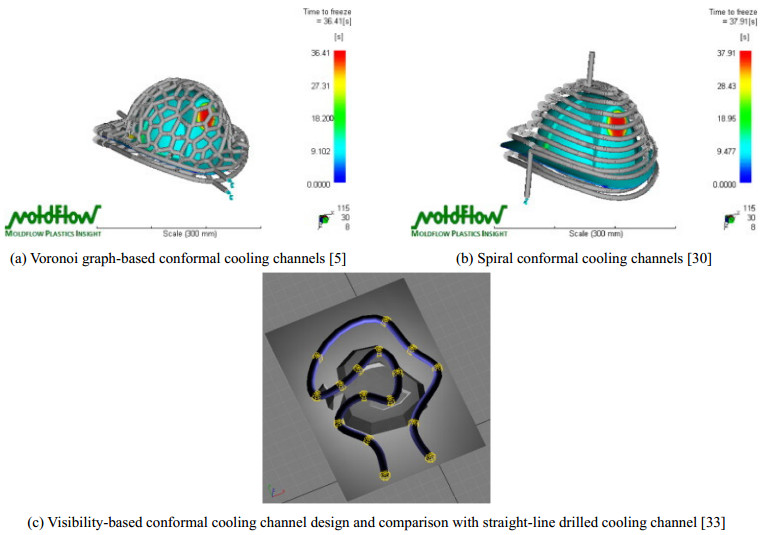









 DownLoad:
DownLoad:
